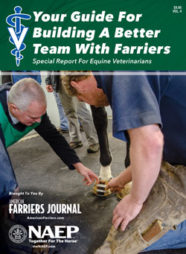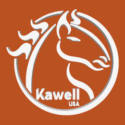A farrier practice is a business — that is no surprise. As professionals, practitioners have a responsibility to maintain accurate records, schedule properly, bill and receive payment promptly, and track performance. At the same time, farriers also should keep records on clients and the type of work conducted on their horses, including photographs of the feet or radiographs shared by veterinarians.
As you build your practice, you likely will gain dozens of clients, details on their specific horses and any long-range measures and goals can be difficult to recall.
Accurate notes on horses must be accessible at all times, as farriers never know when a client might call with an issue. Having crucial information about the horse in hand, rather than sitting in a file cabinet, saves time and money.
Professionals, such as veterinarians, like to work with other professionals and often will recommend those who appear more professional, as it makes them look better to their own clients.
Handwritten notes can still manage a practice, but proper use of computer technology can improve efficiency and professionalism, while ensuring the accuracy.
Move Beyond Handwritten
Starting out as a farrier, you should consider skipping pen and paper and manage aspects of your business with software. Farriers of the previous generation who utilize computer technology for records and invoicing say the first transition step is to recognize the motivation.
Using software portrays you as a stronger hoof-care professional.
Having information on hand, rather than in a filing cabinet, saves time and money.
Mobile payment devices help you collect payments for quicker cash flow.
When David Nicholls started in farriery, home computers didn’t exist.
“I know that there are people who shy away from computers, but I see their use as just the same as any new technique,” explains the West Sussex, England, farrier. “Continued professional development is normal in almost every other industry, so why should farriery be any different? Farriery is a business, so I had no problem integrating software into my practice.”
Nicholls quickly saw the positive effects that record-keeping software had on his time. He has identified several time-saving benefits of using software to manage his business:
- No need for duplicate entries.
- Quickly generate financial reports.
-
Easy monitoring of product use
and inventory. - Immediate access to information on the horses needed by both veterinarians and insurance companies.
- Ability for financial planning, forecasting expenses, etc.
Farrier-Specific Systems
There’s no shortage of small business accounting software programs for both computers and mobile devices. These programs work well for maintaining invoices, payments, taxes and even employee records. Others can be used for scheduling to maintain contact with clients for on-time regular visits. And with today’s technology, invoices can be emailed or printed, depending on a preference, with payment accepted online or via debit or credit card.
Unfortunately, they aren’t designed with farriers in mind and may require formatting to adapt to a farrier business.
There are, however, accounting and scheduling programs designed specifically for farriers. There are similarities among these, but also differences. Each one has a website so you can learn more about the product.
BillThis. The BillThis software for farriers is available on smartphones, tablets and desktop or laptop computers. It allows the user to invoice and accept payment through PayPal. It also lets you manage inventory on your rig, manage appointments, create routes and collaborate with others within a practice. As an additional service, BillThis can import your client contact information into the program. You can learn more about BillThis at billthis.com/farriers.
“There are essential skills you need to be successful,” says Robert van Dam, founder of BillThis. “Certainly the actual skill set to do the work, but without the skill to run a business, it doesn’t matter if you are skilled as a horseshoer. Your business will fail.”
As a small business owner for 3 decades, van Dam understands the need to invoice promptly and remain in contact with customers so that you are on their minds.
“Your customers will usually be affluent — after all, they can afford horses — they care about horses, are engaged and are connected online,” he says. “The customer has a greatly different expectation of working with a farrier than often what the farrier does.”
Van Dam’s goal with this app is to alleviate much of the management the farrier has to do after hours. For example, inventory management is critical. Using his software will allow you to know when you need to order supplies, rather than being without the necessary inventory while in the field.
Using an app like this is a way to distinguish yourself from competition, according to van Dam. Presenting this professional image removes the concern about raising prices because the “other guy” charges less. Perhaps he does charge less, but does that farrier cater to clients as well as you do?
“Determine the value that you provide to the customer,” he says.
EEDS. The Equine Educational and Diagnostic Software (EEDS) from TTI Enterprises is designed for farriers with record locations for both client accounts and methods used. You can view and share images and X-rays with your footcare clients and colleagues. It also employs a complete accounting system. You can learn more about this software at ttienterprises.org/members.
Billy Bishop of Inverness, Fla., is both a farrier and representative with EEDS. He says keeping digital records proves your worth to a client.
“In this field, it seems to me that there is more value placed on you if you have salt and pepper hair than that of a young person,” he says. “People want experience. With records, you can demonstrate expertise.”
Bishop adds that when customers see you taking notes and reviewing them, they will perceive you as more professional than that of farriers who don’t.
“When clients see me taking pictures or entering records, they can tell that I’m engaged, that I’m not there taking money,” he says.
If you want to incorporate software into your practice, Bishop says to start slow. Start with a small set of horses and learn the software before incorporating it into your entire practice.
Besides utilization of software, Bishop recommends using a tablet with equine anatomy apps on it so that you can better explain principles of anatomy and biomechanics to clients.
Farriers Manager and Barefoot Manager. Based in England, Ambrit Software Ltd. offers farrier and barefoot practitioner versions of their “traditional” and mobile software. Farriers Manager specifically was designed to provide electronic record keeping for farriers, providing locations for client contact, scheduling and bookkeeping, similar to general business software programs. You can learn more at ambritsoftware.com.
John Fligg, the founder of Ambrit Software says it is crucial for farriers to understand what exactly they want to accomplish with a product and how the product accomplishes that goal. For example, people favor smartphones as devices. However, your software might not display to your liking due to a smaller screen.
“You soon realize that a tablet is a better device, screen-wise,” he says. “The media teaches that smartphones are the in thing and that smartphones can do anything, and the consumer is mislead. Their expectations are beyond the reality.”
iForgeAhead. iForgeAhead is an Internet-based program that can be used across the gambit of available devices — laptops, tablets and smartphones. It allows multiple users to access information, while allowing for the main user to limit certain information, such as financial records, and even eliminate access if needed. Workers can view needed information on horses and clients, but can’t access the entire system. If you don’t have an Internet connection at a barn, the system utilizes a remote app. You can learn more about this at iforgeahead.com.
Julie Schwalm of Backroads Data, the creator of iForgeAhead, says you should commit to the software for the initial point of usage. A haphazard approach will result in decreased efficiency and lost productivity.
Like any system, data entry is a chore that no one looks forward to. With record-keeper software, there is a lot of data concerning your customers and their horses. Schwalm says you can best take advantage of the technology by having customers perform the data entry.
“In the cases where the customer is there while you are working, pull up the program before you begin working and have them enter the information. They can do this while you work on the horses. This saves you from doing the work, as well as improves the accuracy of the data.”
Schwalm says it also gives a feeling of involvement for the customer.
“When you are starting out, you are building a brand,” she adds. “By immediately managing the business more professionally, it creates an image the clients buy into.”
Schwalm recommends using automated technology to improve your contact with customers, such as appointment reminders.
“Using tools like appointment reminders sometimes are worth the cost of the program,” she reasons. “Saving you from missing one appointment could cover that cost.”
Choosing And Using A Program
With the multitude of programs available, farriers have to choose which is best for their business practices. This brings up some questions, such as: Do you want to be fully electronic? Do you need photo capabilities? Do you want a downloaded version? Or one that is Internet based? And, of course, how much do you want to spend?
Getting started with any of these programs requires discussions with clients to alleviate any concerns about privacy and loss of information. Farriers have to be diligent to maintain the safety of customers’ information, and explain those safety measures. Also, farriers need to explain how this will be beneficial to clients and their horses’ care, as well as what will be needed from clients, such as an email address and acceptable forms of payment. It is important to ensure safe payment for clients, but most people fully understand credit cards, PayPal and bank transfers.
“I have never had a client refuse my request for their details,” says Nicholls. “It has always been a positive response and improved my professional standing with clients, setting me above others.”
Nicholls allows clients to input their own information and updates annually. For those few who aren’t keen on computers, he has them confirm information on a paper record and later enters the information. Clients will be impressed with your creation and access to records, but Nicholls has found a way to further engage them. By having clients input some information, you solidify their role as a team member rather than simply being a customer.







